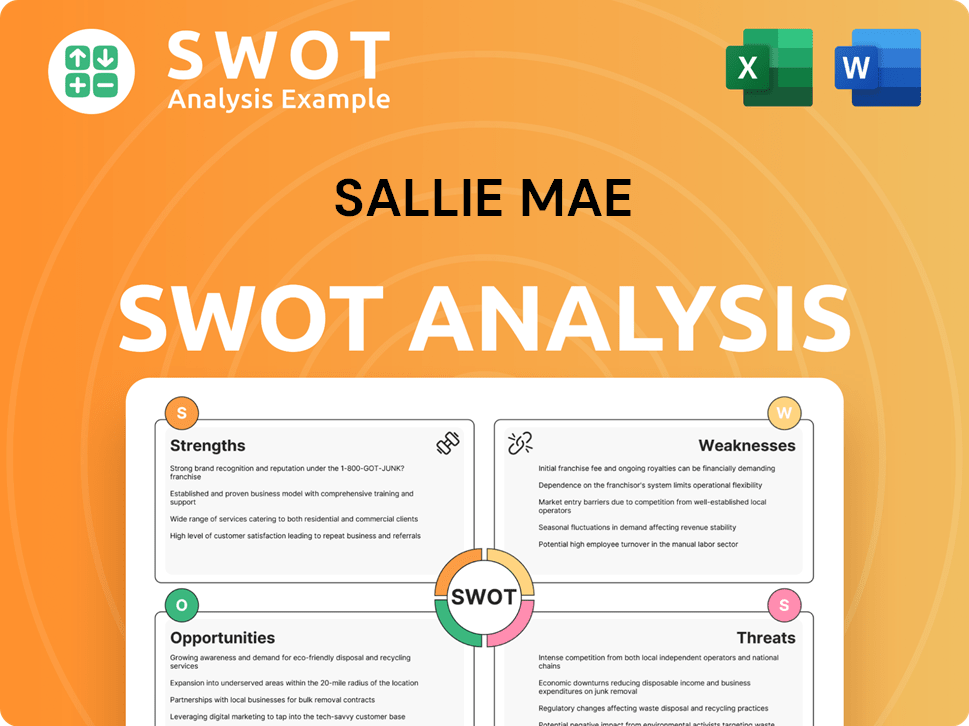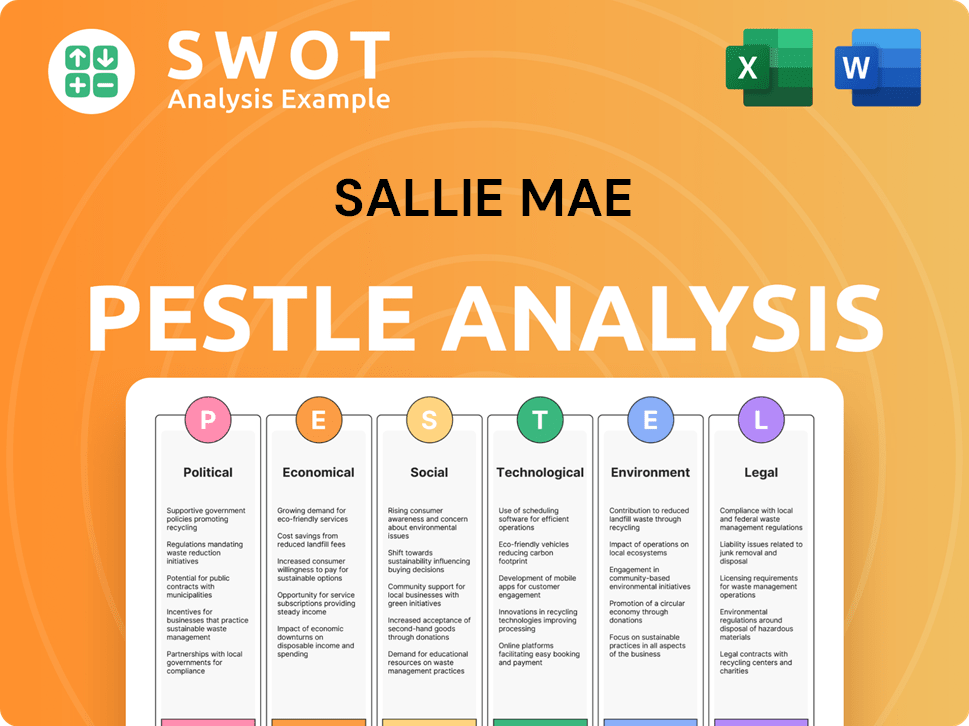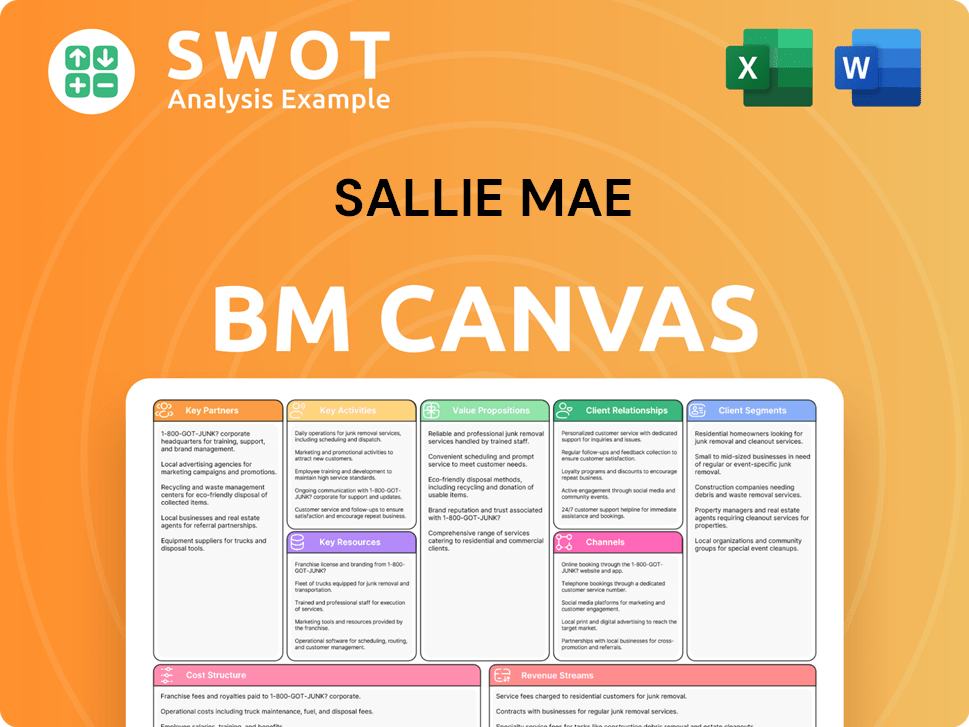Sallie Mae Bundle
Who Really Calls the Shots at Sallie Mae?
Understanding the ownership structure of a company is crucial for investors and stakeholders alike. Sallie Mae's journey from a government-sponsored entity to a publicly traded corporation is a fascinating case study in financial evolution. This transformation has significantly impacted its strategic direction and operational focus, making it a key player in the education loan market.

Sallie Mae, formally known as SLM Corporation, began its journey on June 23, 1972, as the Student Loan Marketing Association, aiming to create a secondary market for student loans. Today, as a leading Sallie Mae SWOT Analysis reveals, the company, headquartered in Newark, Delaware, focuses on originating, servicing, and collecting private education loans. Its evolution sheds light on key aspects such as Sallie Mae ownership, its relationship with Navient, and its current status as a publicly traded education loan company. Understanding who owns Sallie Mae is essential for anyone evaluating its long-term prospects and strategic decisions.
Who Founded Sallie Mae?
The story of Sallie Mae, originally known as the Student Loan Marketing Association (SLMA), begins in 1972. It was established by the U.S. Congress, marking its unique status as a government-sponsored enterprise (GSE). This setup meant it wasn't founded by individual entrepreneurs but rather by the federal government to support the student loan market.
Sallie Mae's initial mission was to create a secondary market for federally guaranteed student loans. Edward A. Fox was appointed as the first President and CEO, and Edward McCabe was named Chairman of the Board. The company officially opened its doors on May 14, 1973, in Washington, D.C.
As a GSE, Sallie Mae had certain advantages, such as exemptions from state and local taxes. Early investors included universities and banks, which acquired voting shares in the company. For example, Harvard University invested $400,000 in 1974, which grew to $14 million by the end of 1983, becoming a significant stockholder.
Established by U.S. Congress in 1972 as a government-sponsored enterprise (GSE).
Edward A. Fox served as the first President and CEO, with Edward McCabe as Chairman of the Board.
Universities and banks initially held voting shares, including Harvard University.
Initial capital came from institutions purchasing voting shares, followed by public offerings of non-voting shares.
As a GSE, it initially enjoyed exemptions from state and local taxes.
The company started with limited capital and net worth, leading to conservative management practices.
Understanding the history of Sallie Mae ownership provides valuable insights into its evolution. Initially, Sallie Mae was a GSE, with ownership primarily held by universities and banks. This structure supported its mission to facilitate the student loan market. The early financial backing from institutions like Harvard University, which saw its investment grow significantly, highlights the confidence in Sallie Mae's potential. For more details, explore the Growth Strategy of Sallie Mae.
- Sallie Mae was not founded by individuals but by the U.S. Congress.
- Early ownership was concentrated among universities and banks.
- Harvard University's investment grew from $400,000 to $14 million.
- The initial capital structure involved voting and non-voting shares.
- The company's early years were marked by conservative financial management.
Sallie Mae SWOT Analysis
- Complete SWOT Breakdown
- Fully Customizable
- Editable in Excel & Word
- Professional Formatting
- Investor-Ready Format

How Has Sallie Mae’s Ownership Changed Over Time?
The ownership structure of Sallie Mae has seen significant shifts since its inception. Initially a government-sponsored enterprise, the company transitioned to a private entity. This transformation began with the SLMA Reorganization Act of 1996 and culminated in full privatization at the end of 2004 when Congress terminated its federal charter, effectively dissolving its ties to the government. This shift provided Sallie Mae with greater operational freedom and the ability to explore new business opportunities.
A pivotal moment occurred on April 30, 2014, when Sallie Mae spun off its loan servicing operation and a significant portion of its loan portfolio into a separate, publicly traded entity called Navient Corporation. Following this separation, Sallie Mae refocused its efforts on private student loans, banking products, and credit cards. This strategic move reshaped the company's core business and its relationship with the newly formed Navient.
| Key Dates | Event | Impact on Ownership |
|---|---|---|
| 1996 | SLMA Reorganization Act | Initiated the process of privatization. |
| 2004 | Full Privatization | Terminated federal charter, making it a private company. |
| April 30, 2014 | Spin-off of Navient | Shifted focus to private student loans and other financial products. |
Currently, SLM Corporation, the parent company of Sallie Mae, operates as a publicly traded company on the Nasdaq Stock Market under the ticker symbol SLM. As of July 24, 2024, its market capitalization was $5.46 billion and $6.71 billion as of July 10, 2024. The ownership is diversified among institutional investors, mutual fund groups, individual shareholders, and company insiders. As of June 10, 2025, institutional ownership stands at 104.54%, indicating a high level of institutional investment, with insiders holding 1.17%. Major institutional shareholders include Vanguard Group Inc., BlackRock, Inc., Fmr Llc, Impactive Capital LP, and Boston Partners. Understanding the Target Market of Sallie Mae can provide further insights into the company's operations and financial strategies.
The ownership of Sallie Mae has evolved from a government-sponsored enterprise to a publicly traded company. Key events include privatization and the spin-off of Navient.
- Privatization in 2004 marked a significant shift.
- The Navient spin-off in 2014 reshaped the company's focus.
- Institutional investors hold a significant portion of the shares.
- The company is listed on the Nasdaq under the ticker SLM.
Sallie Mae PESTLE Analysis
- Covers All 6 PESTLE Categories
- No Research Needed – Save Hours of Work
- Built by Experts, Trusted by Consultants
- Instant Download, Ready to Use
- 100% Editable, Fully Customizable

Who Sits on Sallie Mae’s Board?
The current board of directors at Sallie Mae is pivotal in overseeing the company's strategy and governance. The board includes a mix of members, some representing major shareholders and others serving as independent directors. Carter Franke has been the Chair of Sallie Mae's board of directors since June 2020, providing leadership and direction.
In April 2025, Sallie Mae added new members to its Board of Directors. These additions, including Dr. Daniel Greenstein and Mr. Gary Millerchip, bring expertise in higher education strategy and finance, respectively. These appointments are part of the board's ongoing efforts to maintain a diverse skill set to support its oversight of Sallie Mae's business and operations. The company also has a Securities Trading Policy to ensure compliance with insider trading laws.
| Director | Title | Since |
|---|---|---|
| Carter Franke | Chair of the Board | June 2020 |
| Dr. Daniel Greenstein | Director | April 2025 |
| Gary Millerchip | Director | April 2025 |
The voting structure at SLM Corporation follows a one-share-one-vote principle for its common stock. As of April 21, 2025, there were 209,856,503 shares of common stock outstanding and eligible to be voted. The company's proxy statements detail proposals requiring stockholder action, such as electing directors and approving executive compensation. For more details on the company's background, you can read the Brief History of Sallie Mae.
Sallie Mae's board is made up of experienced professionals. The voting structure is straightforward, with one vote per share of common stock.
- The board includes independent directors.
- Shareholders vote on important matters.
- The company follows a Securities Trading Policy.
- Carter Franke chairs the board.
Sallie Mae Business Model Canvas
- Complete 9-Block Business Model Canvas
- Effortlessly Communicate Your Business Strategy
- Investor-Ready BMC Format
- 100% Editable and Customizable
- Clear and Structured Layout

What Recent Changes Have Shaped Sallie Mae’s Ownership Landscape?
Over the past few years, the ownership structure of Sallie Mae, a leading education loan company, has remained primarily institutional. As of June 2024, institutional ownership stood at 104.54%, indicating a strong presence of institutional investors in the company's stock. Insider ownership, on the other hand, was at 1.17%, reflecting the stake held by company insiders. This indicates that the company is a publicly traded entity and that the ownership is primarily held by investment firms and other institutional investors.
This ownership profile underscores the company's position in the financial market and its reliance on institutional backing. The company's stock is traded on the NASDAQ under the ticker symbol SLM. Understanding Sallie Mae's ownership is crucial for investors and stakeholders interested in the company's strategic direction and financial performance. Considering the dynamic nature of the financial markets, these ownership percentages can fluctuate over time, so staying informed about Sallie Mae ownership is essential.
Financially, Sallie Mae reported a GAAP net income of $301 million attributable to common stock for Q1 2025, with diluted earnings per share of $1.40. Private education loan originations increased by 7.3% to $2.8 billion in Q1 2025 compared to Q1 2024. The company's strategic approach includes capital management, demonstrated by a common stock dividend of $0.13 per share paid in Q1 2025, and share repurchases. In Q1 2025, Sallie Mae also sold $2.0 billion in private education loans to an unaffiliated third party, resulting in a gain on loan sales of $188 million, and it is projecting a 6-8% growth in private education loan originations for 2025.
Sallie Mae is a publicly traded company, with its ownership primarily held by institutional investors. Institutional ownership is a significant aspect of its shareholder base. The stock is traded on the NASDAQ under the ticker symbol SLM.
In Q1 2025, Sallie Mae reported a net income of $301 million and diluted earnings per share of $1.40. Private education loan originations increased by 7.3% to $2.8 billion. The company also sold $2.0 billion in private education loans.
Sallie Mae is actively managing its capital through dividends and share repurchases. It also strategically sells loans to manage its balance sheet and optimize its portfolio. The company projects 6-8% growth in private education loan originations for 2025.
Sallie Mae anticipates continued growth in the private education loan sector. The company projects GAAP diluted EPS to range between $3.00 and $3.10. The company plans to sell $2 billion in private education loans in 2025.
Sallie Mae Porter's Five Forces Analysis
- Covers All 5 Competitive Forces in Detail
- Structured for Consultants, Students, and Founders
- 100% Editable in Microsoft Word & Excel
- Instant Digital Download – Use Immediately
- Compatible with Mac & PC – Fully Unlocked

Related Blogs
- What are Mission Vision & Core Values of Sallie Mae Company?
- What is Competitive Landscape of Sallie Mae Company?
- What is Growth Strategy and Future Prospects of Sallie Mae Company?
- How Does Sallie Mae Company Work?
- What is Sales and Marketing Strategy of Sallie Mae Company?
- What is Brief History of Sallie Mae Company?
- What is Customer Demographics and Target Market of Sallie Mae Company?
Disclaimer
All information, articles, and product details provided on this website are for general informational and educational purposes only. We do not claim any ownership over, nor do we intend to infringe upon, any trademarks, copyrights, logos, brand names, or other intellectual property mentioned or depicted on this site. Such intellectual property remains the property of its respective owners, and any references here are made solely for identification or informational purposes, without implying any affiliation, endorsement, or partnership.
We make no representations or warranties, express or implied, regarding the accuracy, completeness, or suitability of any content or products presented. Nothing on this website should be construed as legal, tax, investment, financial, medical, or other professional advice. In addition, no part of this site—including articles or product references—constitutes a solicitation, recommendation, endorsement, advertisement, or offer to buy or sell any securities, franchises, or other financial instruments, particularly in jurisdictions where such activity would be unlawful.
All content is of a general nature and may not address the specific circumstances of any individual or entity. It is not a substitute for professional advice or services. Any actions you take based on the information provided here are strictly at your own risk. You accept full responsibility for any decisions or outcomes arising from your use of this website and agree to release us from any liability in connection with your use of, or reliance upon, the content or products found herein.